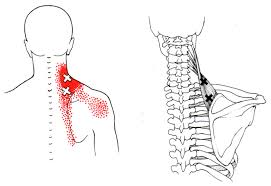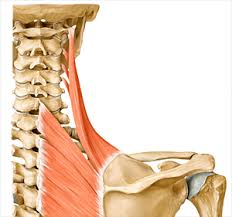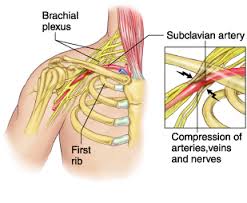Levator Scupula Muscle Related Neck pain
When you wake up in the morning with neck pain, a crick in your neck, feel a burning pain on the top inner corner of your shoulder blade, or have trouble turning your head to look behind you while driving etc., the culprit may be a Levator Scapula muscle in spasm. The pain can be described as a throbbing, ache, or tightness. It usually presents from the top inner corner of the shoulder blade up along the neck. The Levator Scapulae muscles are located on either side of the neck. They originate on the four upper vertebrae of the cervical spine (neck). They insert, or attach, to the scapula, also known as the shoulder blade at the superior, medial border. These two muscles are involved in elevation, downward rotation and abduction of the scapulae. They are also involved in flexion and extension of the cervical spine(neck), turning of the neck slightly left and right, along with side bending of the neck left and right.


What Causes Levator Scapula Spasm / Trigger Points?
A trigger point is a tight area within muscle tissue that causes pain in that area and/or other parts of the body. The trigger points are shown above as two dark red circles, with the pain referral area also shaded in. Muscle spasm is a tightening of a muscle usually, due to overuse or overstress. It can in itself cause pain and loss of mobility.
Causes
The following events and activities are likely to activate, or reactivate, tension / pain and trigger points in the levator scapulae.
- whiplash from an automobile accident
- sleeping on the stomach with the head turned/or sleeping in an odd position
- chilling of the muscle during sleep from an air conditioner or draft from an open window
- working at a computer with the head turned for long periods
- holding a phone between the shoulder and ear
- carrying a heavy bag with a shoulder strap
- use of crutches that are too tall and elevate the shoulder
- emotional and mental stress
- Working with your arms raised above your head for prolonged periods of time can also irritate the Levator Scapula. To help reduce neck pain, stabilize your shoulder blade when you raise your arm.
- poor posture with a forward head position puts this muscle under continuous strain causing overuse.
Treatment for Levator Scapula Muscle Spasm / Trigger points
Usually the condition settles after a few days if it is only a once off. Proper hands-on deep tissue massage and dry needling, when used together, can be great to settle the condition either in the short term, or if the condition has become more chronic. Also for the long term, correcting posture, stretching and strengthening of the upper back(particularly middle / lower traps, serratus posterior, rhomboids etc.) and the neck muscles(specifically the posterior neck muscles) can help prevent the condition from returning.
Posture
Posture is key to a healthy neck and spine. Try and sit up straight on a comfortable supportive chair, when at work or at home. Allow your shoulders to relax by using the arm rests of the chair. When at a computer, pull the screen close and try to get the screen up at eye level (say using books underneath it). This will mean your head won’t have to be protruding forward. The same applies when driving a car. Pull the seat in close to the steering wheel(within reason). Try to position yourself so the shoulders are relaxed and the head isn’t jutting forward. Activities like reading in bed, playing computer games for hours etc. can really tighten up the levator muscles. They are a disaster for thoracic and cervical posture in the long term.
For more information click to see this video
Physiotherapist in Tralee Phone 086-7700191
